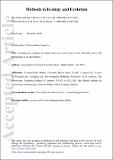Listening and watching : do camera traps or acoustic sensors more efficiently detect wild chimpanzees in an open habitat?
Abstract
1. With one million animal species at risk of extinction, there is an urgent need to regularly monitor threatened species. However, in practice this is challenging, especially with wide‐ranging, elusive and cryptic species or those that occur at low density. 2. Here we compare two non‐invasive methods, passive acoustic monitoring (n=12) and camera trapping (n=53), to detect chimpanzees (Pan troglodytes) in a savanna‐woodland mosaic habitat at the Issa Valley, Tanzania. With occupancy modelling we evaluate the efficacy of each method, using the estimated number of sampling days needed to establish chimpanzee absence with 95% probability, as our measure of efficacy. 3. Passive acoustic monitoring was more efficient than camera trapping in detecting wild chimpanzees. Detectability varied over seasons, likely due to social and ecological factors that influence party size and vocalisation rate. The acoustic method can infer chimpanzee absence with less than ten days of recordings in the field during the late dry season, the period of highest detectability, which was five times faster than the visual method. 4. Synthesis and applications: Despite some technical limitations, we demonstrate that passive acoustic monitoring is a powerful tool for species monitoring. Its applicability in evaluating presence/absence, especially but not exclusively for loud call species, such as cetaceans, elephants, gibbons or chimpanzees provides a more efficient way of monitoring populations and inform conservation plans to mediate species‐loss.
Citation
Crunchant , A-S , Borchers , D , Kühl , H & Piel , A 2020 , ' Listening and watching : do camera traps or acoustic sensors more efficiently detect wild chimpanzees in an open habitat? ' , Methods in Ecology and Evolution , vol. 11 , no. 4 , pp. 542-552 . https://doi.org/10.1111/2041-210X.13362
Publication
Methods in Ecology and Evolution
Status
Peer reviewed
ISSN
2041-210XType
Journal article
Description
This work was supported by the Primate Society of Great Britain through the Cyril Rosen Conservation Grant. Long term funding for ongoing research at Issa is supported by the UCSD/Salk Center for Academic Research and Training in Anthropogeny (CARTA).Collections
Items in the St Andrews Research Repository are protected by copyright, with all rights reserved, unless otherwise indicated.

